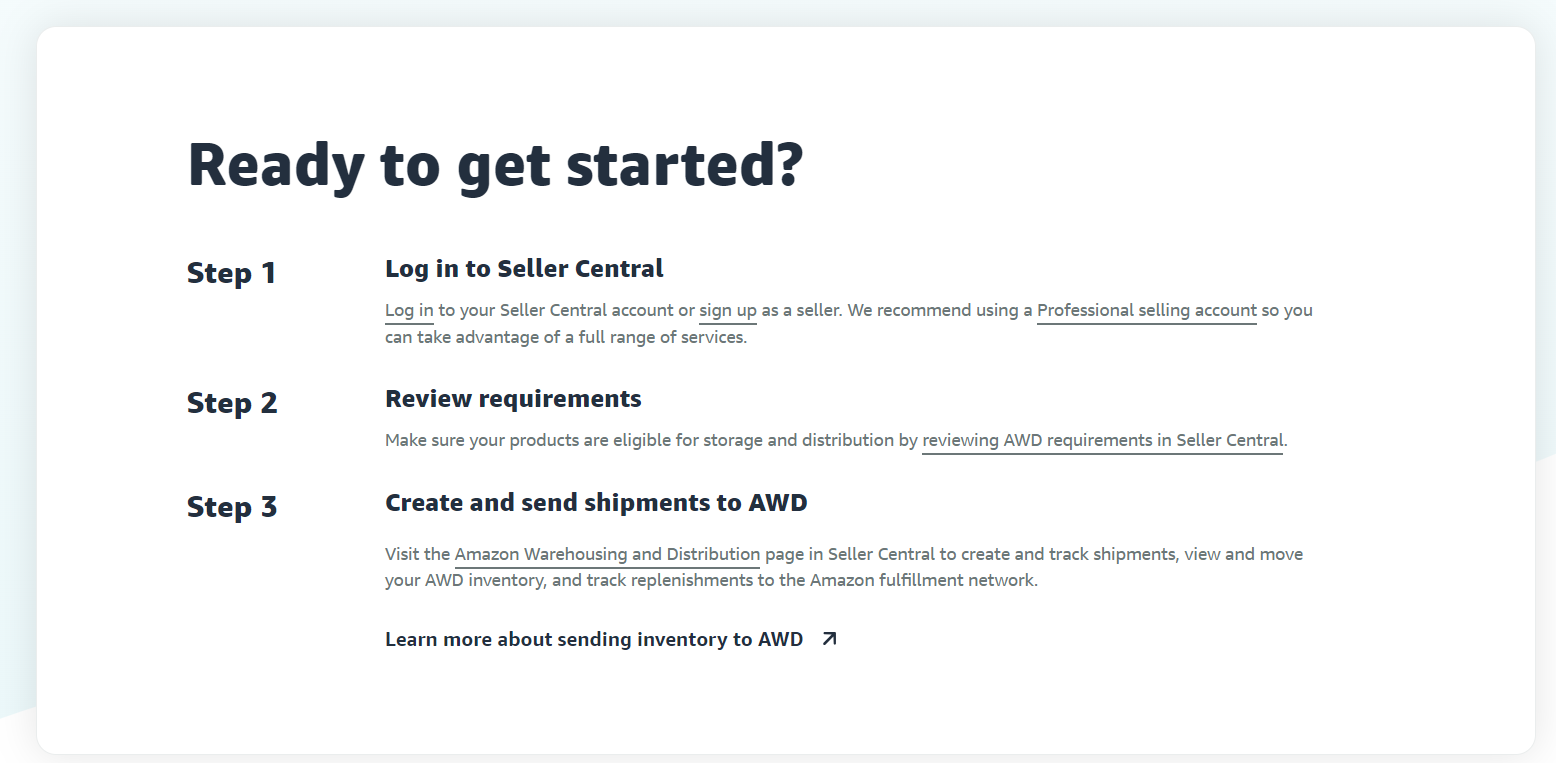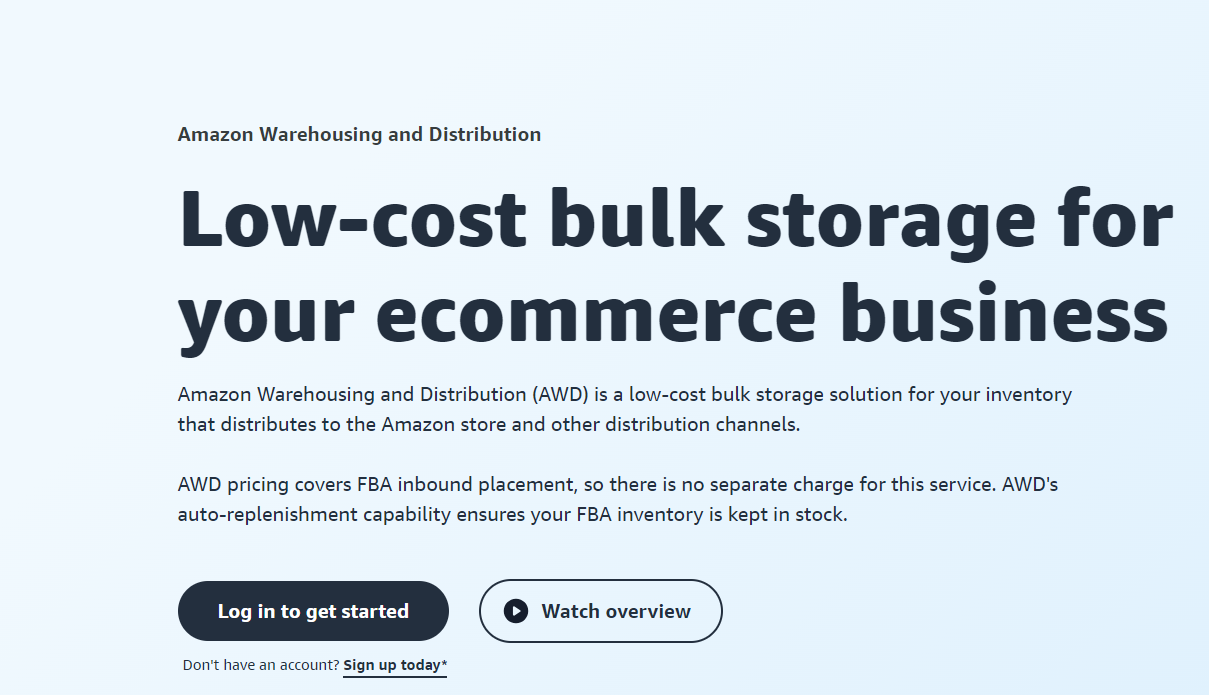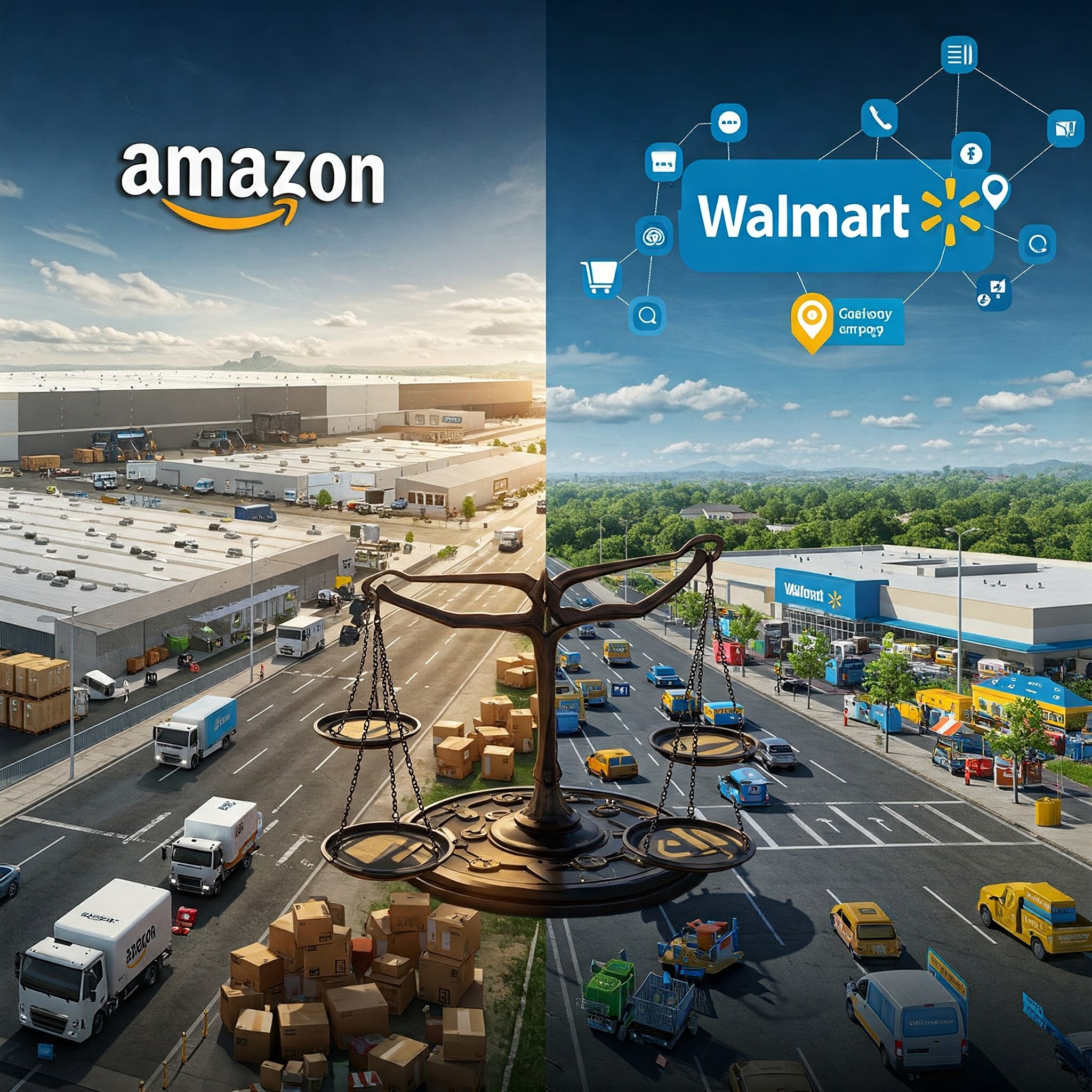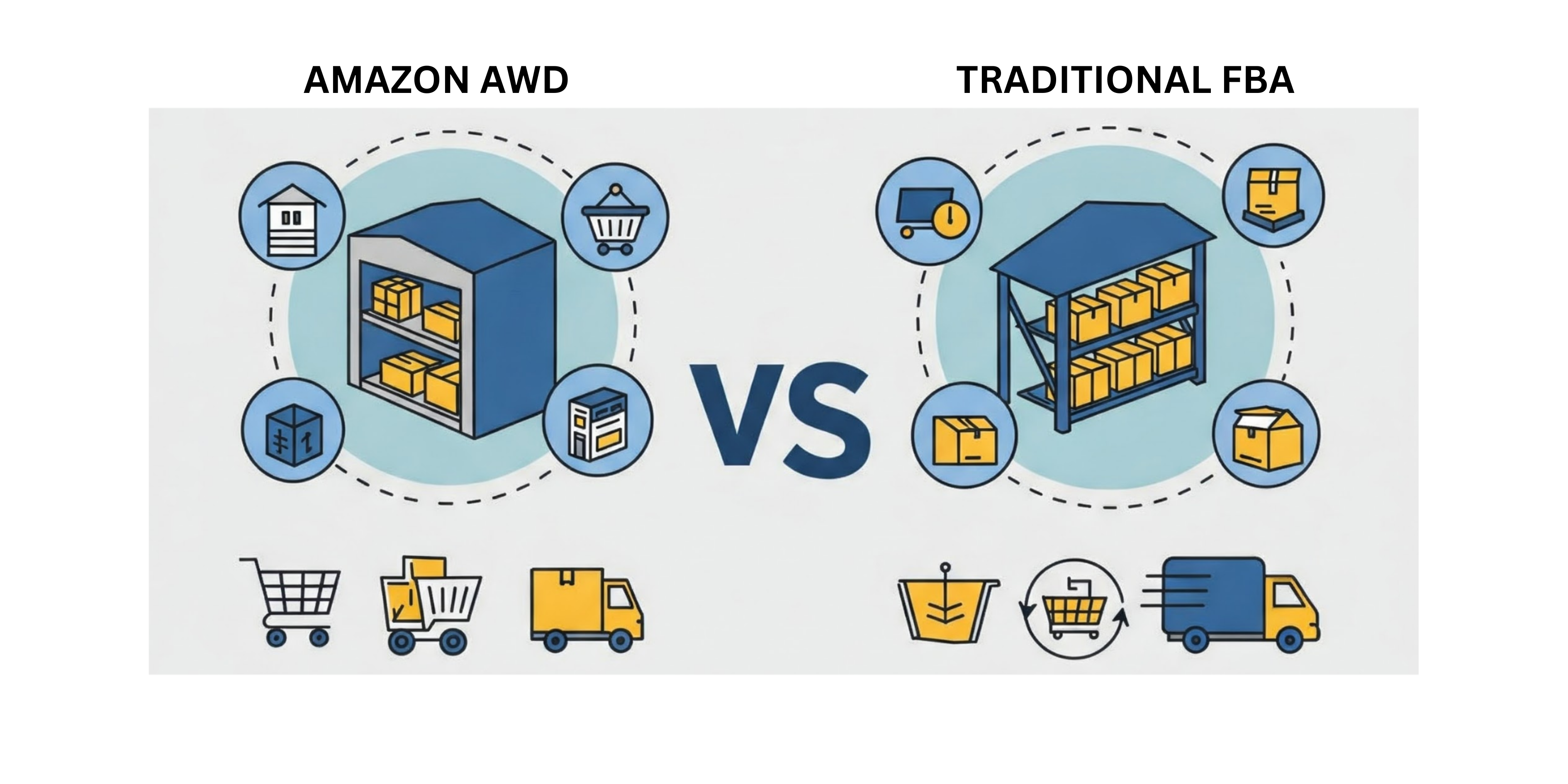Maximizing Efficiency with Amazon Warehousing and Distribution (AWD): Your Ultimate Guide
In the continuously changing world of e-commerce, inventory management and assuring swift, dependable delivery to clients can be difficult. These activities can be costly for firms, particularly as they expand. This is where Amazon Warehousing and Distribution (AWD) steps in. AWD was launched as a new fulfillment solution with the goal of making it easier and less expensive for sellers to store, manage, and distribute their products. This article will explain what AWD is, its essential characteristics, how it differs from typical fulfillment services, and how to use it effectively. We will also look at real-world examples to help you understand how AWD may transform your organization.
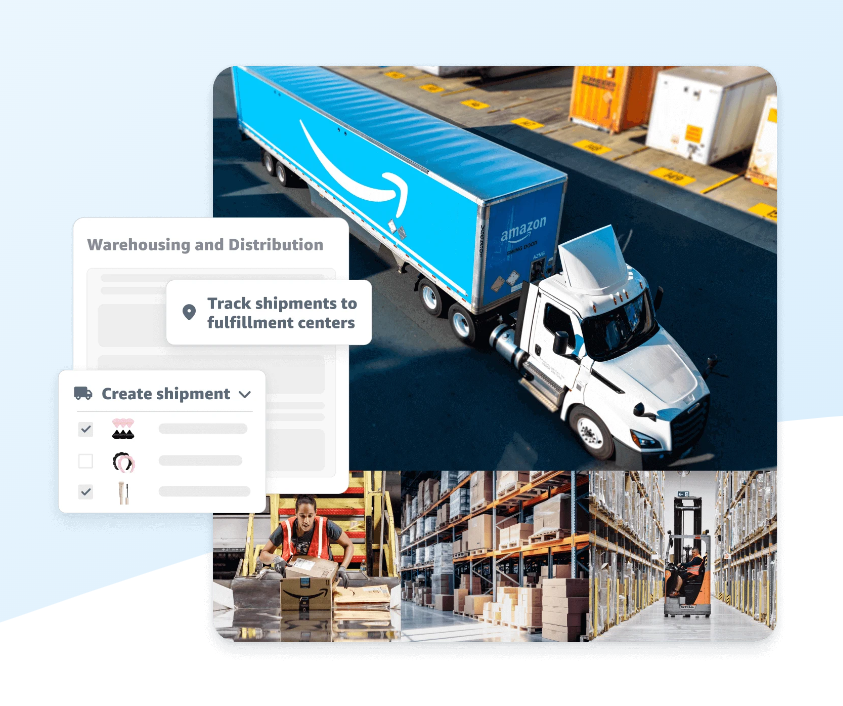
Image Source is Amazon
What is Amazon Warehousing and Distribution (AWD)?
A new fulfillment service called Amazon Warehousing and Distribution (AWD) was created to give companies an affordable option for storing their inventory. It's not only storage, though. Because AWD and Fulfillment by Amazon (FBA) work so well together, companies can keep their goods in an Amazon warehouse and then quickly distribute them via FBA or other sales channels as needed.
Several online retailers find inventory management to be challenging, particularly when managing several platforms. Whether you sell on Amazon or other e-commerce platforms, AWD offers a single solution for inventory management and storage, which streamlines this process.
Key Features of AWD
Let’s break down some of the main features that make AWD so appealing for online sellers.
-
Affordable Storage
One of AWD’s most significant benefits is its low-cost storage option. Businesses can store their products at an affordable rate of $0.48 per cubic foot per month. If you use Amazon’s own logistics service for transporting goods, this rate can drop to $0.36 per cubic foot. This makes it a more affordable alternative compared to traditional warehousing services, which often come with much higher storage fees. The savings are especially significant for businesses with large inventories, which can rack up substantial costs in traditional warehouses.
-
Auto-Replenishment
Another notable feature of an AWD is its auto-replenishment system. This tool automates the process of keeping your inventory in stock. AWD monitors your inventory levels and automatically restocks items before they run out. This ensures that you never experience stockouts, which can result in lost sales and unsatisfied consumers. Maintaining a continuous supply of products allows you to focus on building your business rather than worrying about manual inventory management.
-
Fast Processing and Reliability
Speed is vital in ecommerce, and AWD provides short turnaround times. When goods arrive at an AWD warehouse, it is usually processed and visible in your system within 2 to 4 days. When you need to deliver products from AWD to Amazon's FBA hubs for fulfillment, the procedure takes 10-14 days. This speedy turnaround ensures that your products are constantly ready for sale, reducing downtime and increasing customer happiness.
-
Multi-Channel Distribution
AWD also offers multi-channel distribution, which enables firms to manage inventories across many platforms from one location. Whether you sell on Amazon, your own website, or another online marketplace, AWD makes it simple to track and manage your inventory all in one location. This simplifies logistics by reducing the need to manage numerous inventory pools and distinct fulfillment processes.
Image Source is Amazon
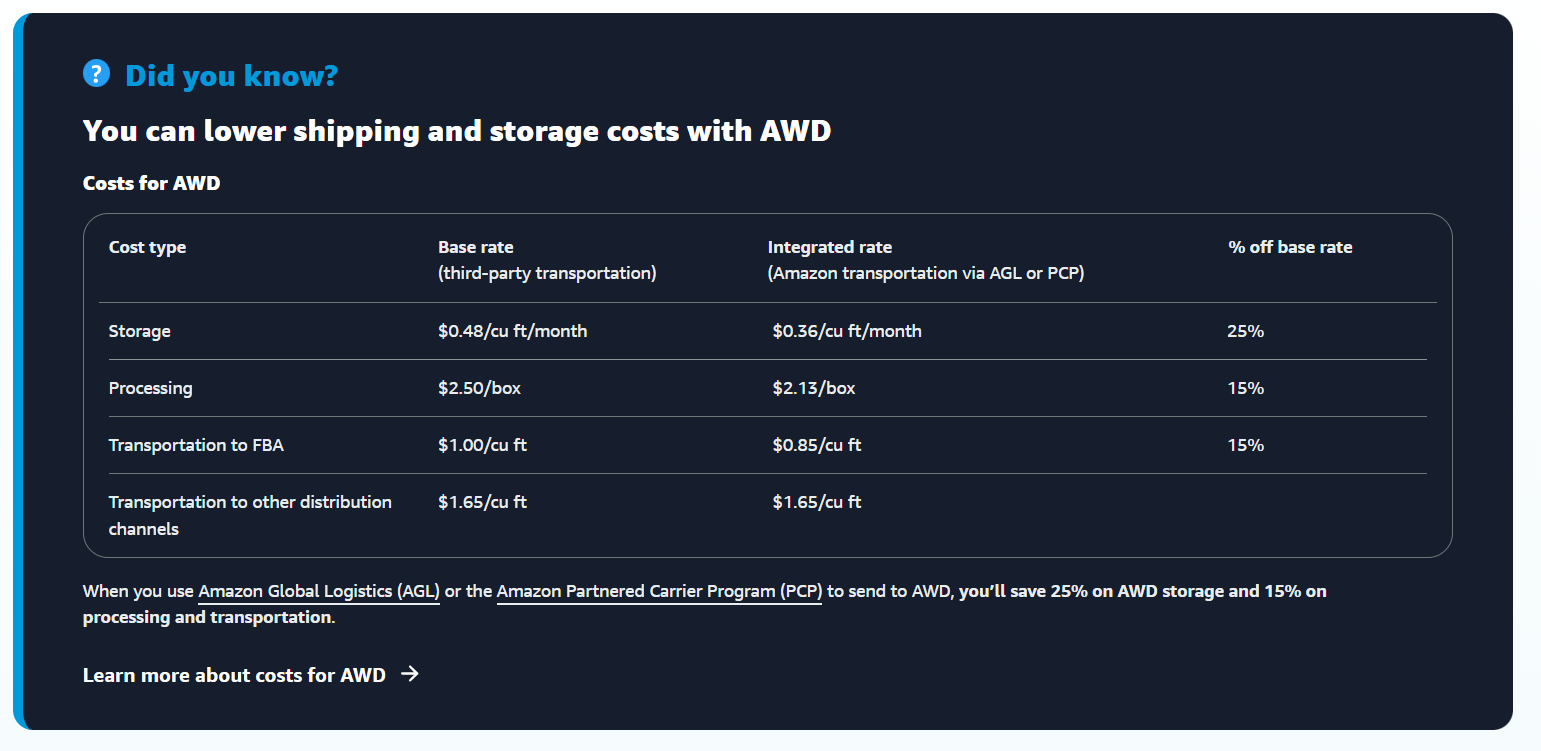
Comparing AWD with Traditional Fulfillment Services
Now that you know what AWD offers, let’s compare it to traditional fulfillment services to understand the differences and advantages better.
Cost Efficiency
Traditional fulfillment firms usually charge greater storage and handling fees, particularly for bulk merchandise. AWD has substantially cheaper rates, which can result in significant cost savings for organizations, particularly those with large inventory demands. The lower fees for using Amazon’s logistics services further enhance these savings, making AWD a more budget-friendly option for businesses of all sizes.
Automation and Integration
Many traditional warehouse and fulfillment services demand more manual intervention, particularly when it comes to inventory replenishment and order management. AWD's auto-replenishment technology automates most of this process, reducing human error and assuring a consistent supply of merchandise. Furthermore, the integration of AWD, FBA, and other Amazon services provides a unified platform for controlling inventory and orders. Traditional services may not provide the same amount of automation or integration, thus AWD is a more efficient alternative for many firms.
Flexibility and Scalability
Traditional fulfillment providers frequently lack the flexibility and scalability required to support rapidly growing organizations. AWD is designed to be adaptable and scalable, capable of handling bulk storage and multi-channel distribution for organizations of various sizes. Whether your company is small, medium, or large, AWD can adapt to your changing demands, making it easier to expand without encountering major logistical issues.
Real-World Examples: How Different Businesses Benefit from AWD
To better understand how AWD can help, let’s look at a few examples of how businesses of different sizes and types can leverage AWD’s features.
-
Small Business - Handmade Crafts
Imagine a small business that specializes in handmade crafts. The owners might struggle with finding enough space to store their products while also keeping costs low. By using AWD, this business can take advantage of affordable storage rates, allowing them to store more products without overspending. Plus, the auto-replenishment feature ensures that popular items are always in stock, reducing the risk of running out during peak sales times.
-
Medium-Sized Business - Electronics Retailer
A medium-sized electronics retailer with a variety of products can also benefit from AWD’s multi-channel distribution feature. By storing all their inventory in an AWD warehouse, this business can manage products for both Amazon and other platforms from one location. This not only reduces shipping costs but also simplifies the logistics of handling inventory across multiple sales channels. The fast processing times also mean that products are always ready for sale, helping the business meet customer demand more efficiently.
-
Large Enterprise - Global Clothing Brand
For a large clothing brand with international operations, managing global logistics can be a massive challenge. AWD can simplify this process by offering affordable storage and efficient replenishment across multiple markets. By integrating AWD with Amazon’s global logistics services, the brand can manage its inventory in different regions, making sure products are available for customers no matter where they are in the world. This reduces shipping complexity and ensures timely delivery to customers worldwide.
Advanced Features of AWD
Beyond its basic features, AWD offers several advanced capabilities that can further enhance its value for businesses.
-
Real-Time Analytics
AWD provides a dashboard that allows businesses to track inventory levels, manage shipments, and analyze performance in real time. These analytics tools help businesses make informed decisions, optimize inventory management, and identify trends that can help drive sales.
-
Custom Packaging
AWD supports custom packaging, which allows businesses to present their products in branded, eye-catching packaging. This feature enhances the customer experience and helps create a stronger brand impression, which is especially important in today’s competitive e-commerce market.
-
Scalability
As your business grows, AWD can easily scale with you. Whether you’re expanding your product lines or entering new markets, AWD’s scalable solutions can handle increased inventory without overwhelming your business with logistical challenges.
Integration with Other Amazon Services
AWD’s value is even greater when you consider its integration with other Amazon services, which helps streamline the entire fulfillment process.
-
Fulfillment by Amazon (FBA)
AWD works seamlessly with FBA, which means businesses can use AWD for storage and then leverage Amazon’s fulfillment network to deliver products to customers. This integration simplifies the process of managing orders, inventory, and shipments from a single platform.
-
Amazon Global Logistics (AGL)
For businesses shipping internationally, Amazon Global Logistics (AGL) offers a cost-effective way to transport goods to AWD warehouses. By using AGL, businesses can reduce shipping costs and manage global logistics more efficiently.
-
Amazon Seller Central
AWD is fully integrated with Amazon Seller Central, which is the platform Amazon sellers use to manage their listings, track orders, and handle inventory. With AWD built into Seller Central, businesses can manage everything in one place, making the entire process much easier.
Practical Tips for Maximizing AWD’s Benefits
To get the most out of AWD, here are some practical tips you should follow:
- Monitor Inventory Levels: Regularly check your inventory using AWD’s analytics tools to ensure products are always in stock. This helps you avoid stockouts and ensures you’re always ready to meet customer demand.
- Optimize Auto-Replenishment Settings: Adjust your auto-replenishment thresholds based on your sales trends and seasonal demand. This ensures that products are restocked at the right time, preventing both stockouts and overstocking.
- Use Multi-Channel Distribution: Take full advantage of AWD’s multi-channel capabilities to manage inventory across different sales platforms from one place. This will save you time and simplify your logistics.
- Leverage Custom Packaging: Consider using AWD’s custom packaging options to enhance your brand’s presentation. This small detail can go a long way in creating a memorable customer experience.
- Utilize Amazon Global Logistics: If you’re selling internationally, using Amazon Global Logistics can help reduce your shipping costs and simplify the process of getting products to AWD.
Conclusion
Amazon's Warehousing and Distribution (AWD) initiative provides an effective new alternative for online sellers wishing to improve inventory management and delivery. With its low-cost storage, automation, and connectivity with Amazon's other services, AWD may help businesses save money, improve efficiency, and increase customer happiness.
While AWD has several advantages, it's crucial to consider how well it meets your company's specific requirements. You may assess whether AWD is the best option for your business by carefully weighing the cost savings, speed, and scalability.
Incorporating AWD into your logistics strategy can help take your organization to the next level, resulting in improved efficiency and decreased costs.
Image Source is Amazon
